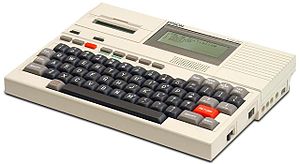Epson HX-20

The Epson HX-20
|
|
| Also known as | HC-20 |
|---|---|
| Manufacturer | Seiko Epson |
| Release date | July 1982 |
| Introductory price | US$795 (today $1911.67) |
| CPU | two Hitachi 6301 CPUs at 614 kHz |
| Memory | 16 kB RAM expandable to 32 kB 32 kB ROM expandable to 64 kB |
| Display | 4 lines x 20 characters LCD |
| Graphics | 120 × 32-pixel |
| Input | full-transit keyboard |
| Power | rechargeable nickel-cadmium batteries |
| Dimensions | A4 Sized |
| Weight | approximately 1.6 kg |
The Epson HX-20 (also known as the HC-20) was the first laptop computer. It was invented in July 1980 by Yukio Yokozawa, who worked for Suwa Seikosha, a branch of Japanese company Seiko (now Seiko Epson), receiving a patent for the invention. It was announced in 1981 as the HC-20 in Japan, and was introduced by Epson in North America as the HX-20 in 1981, at the COMDEX computer show in Las Vegas, where it drew significant attention for its portability. It had a mass-market release in July 1982, as the HC-20 in Japan and as the Epson HX-20 in North America. The size of an A4 notebook and weighing 1.6 kg, it was both the first notebook and handheld computer, for which it was hailed by BusinessWeek magazine as the “fourth revolution in personal computing”.
Epson advertised the HX-20 with a photograph of the computer on two facing magazine pages with the headline "Actual size". With about the footprint of an A4 size page, the Epson HX-20 features a full-transit keyboard, rechargeable nickel-cadmium batteries, a built-in 120 × 32-pixel LCD which allowed 4 lines of 20 characters, a calculator-size dot-matrix printer, the EPSON BASIC programming language, two Hitachi 6301 CPUs at 614 kHz which is essentially a souped up Motorola 6801,16 kB RAM expandable to 32 kB, two RS-232 ports at a maximum of 4800 bits/s for the first 8-pin DIN connector intended for modem or serial printer with the second port capable of 38400 bits/s using a 5-pin DIN connector which was mainly for use with external floppy drive and video display an early concept of docking station, a 300 bit/s acoustic coupler was available, built-in microcassette drive, barcode reader connector. Uses a proprietary operating system, which consists of the EPSON BASIC interpreter and a monitor program, and weighs approximately 1.6 kg. Known colours of the machine are silver and cream, while some prototypes were dark grey. The HX-20 was supplied with a grey or brown carry case. An external acoustic coupler, the CX-20, was available for the HX-20, as was an external floppy disk drive, the TF-20, and an external speech synthesis Augmentative Communication Device (ACD), ‘RealVoice’. Another extension was the serially connected 40 × 24 character video. It used a special protocol, EPSP, which was also used by the external floppy disk drive. The battery life of the HX-20 was approximately 50 hours running BASIC and less using the microcassette, printer or RS-232. Data integrity could be preserved in the 4.0 - 6.0 V range. The power supply was rated for 8 W. Operating and charging it would tolerate 5 - 35 °C. Data integrity could be preserved at -5 - 40 °C. The HX-20 could be stored between -20 - 60 °C.
...
Wikipedia
